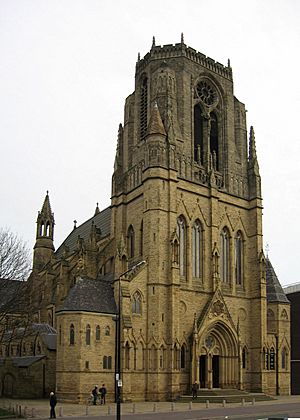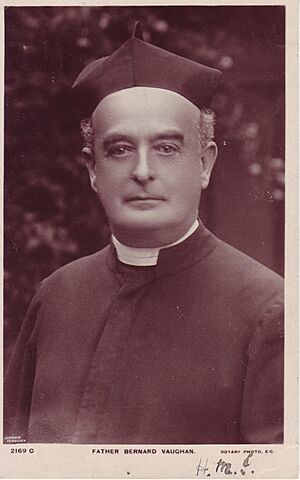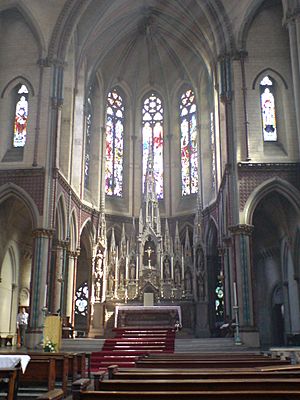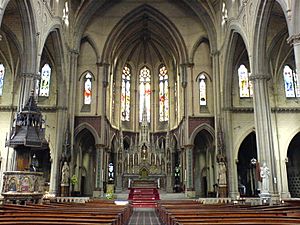Church of the Holy Name of Jesus, Manchester facts for kids
Quick facts for kids Holy Name Church |
|
|---|---|
| Church of the Holy Name of Jesus, Chorlton on Medlock | |

View of the entrance
|
|
| Lua error in Module:Location_map at line 420: attempt to index field 'wikibase' (a nil value). | |
| OS grid reference | SJ8475796438 |
| Location | Manchester |
| Country | UK |
| Denomination | Roman Catholic |
| History | |
| Status | Chapel of ease |
| Founded | 15 October 1871 |
| Founder(s) | Bishop William Turner |
| Dedication | Holy Name of Jesus |
| Consecrated | 1923 |
| Architecture | |
| Functional status | Active |
| Heritage designation | Grade I |
| Designated | 18 December 1963 |
| Architect(s) | J. A. Hansom and Son |
| Architectural type | Church |
| Style | Gothic Revival |
| Groundbreaking | 1869 |
| Completed | 1928 |
| Specifications | |
| Capacity | 800 |
| Length | 186 ft (57 m) |
| Width | 122 ft (37 m) |
| Spire height | 185 ft (56 m) |
| Materials | Moulded Terracotta Warwick Bridge stone |
| Administration | |
| Parish | St. Augustine Church |
| Deanery | Chorlton-on-Medlock |
| Diocese | Salford |
| Province | Liverpool |
The Church of the Holy Name of Jesus is a famous church located on Oxford Road in Manchester, England. It was designed by Joseph Aloysius Hansom and built between 1869 and 1871. The tall tower was added later in 1928. It was designed by Adrian Gilbert Scott to remember a priest named Fr Bernard Vaughan, SJ. This church is considered a very important building. It has been a Grade I listed building since 1989, meaning it's protected because of its special history and architecture.
Contents
Church History
In 1860, William Turner, who was the first bishop of Salford, invited a group of priests called the Jesuits to live in Chorlton-on-Medlock. This area was a growing suburb of Manchester at the time.
Manchester was also home to many Irish immigrants. They came to work in the cotton factories, especially after the Great Famine in Ireland. The local church, St Mary, was too small to help everyone. Many priests there became sick while helping the city's poor.
The Jesuits were known for their great work in helping communities and doing missionary work. They were very good at this. From 1888 to 1901, a priest named Fr Bernard Vaughan SJ was in charge of the church. He took part in public discussions with the Anglican Bishop of Manchester, James Moorhouse. They debated which church was the true Catholic Church in England. After these debates, the young men from Holy Name Church were so happy that they pulled Fr Vaughan's carriage all the way from the city centre to the church!
Building the Church
Bishop Turner really wanted a church in Chorlton-on-Medlock. He wanted priests there who could help people with their questions about faith. Jesuits from St Helens came to Manchester and first used a temporary church. The Holy Name Church became a parish church. It served the growing areas of Longsight and Chorlton-on-Medlock. As Manchester grew, more streets and houses were built.
Building this large church showed how strong the Jesuit order was and how confident English Catholics felt again. It is the biggest church in Manchester and stands out in the area.
Church Size and Design
The church is very large, like a 14th-century cathedral. It is 186 feet (about 57 meters) long and 112 feet (about 34 meters) wide. The architect, Joseph Aloysius Hansom, designed it in a Gothic style, similar to churches in France. Sir Nikolaus Pevsner, a famous expert on buildings, said it was "a design of the very highest quality."
Even though it looks old, the church was built to teach the Catholic faith. It was designed to make the celebration of the Mass (a church service) very clear. The main altar is raised and close to the people. There is no screen blocking the view. The church also has a special place for the Eucharist (a holy bread). Your eyes are drawn to it first. There is also a large pulpit for preaching, so the speaker is close to the people. The north side of the church has many confessionals, which are small rooms where people can confess their sins.
The church's pillars are very thin. This was possible because the roof was made from hollow terracotta tubes. This made the roof lighter.
Materials and Features
The church is built with brick and covered with Warwick stone. It was suggested that Hansom's first plan included a broad steeple 73 feet (about 22 meters) high. However, the tower that was built in 1928 was designed by Adrian Gilbert Scott.
The main part of the church, called the nave, can hold 800 people. Small chapels are on the south side. The baptistery, where baptisms happen, is towards the west. On the north side are the confessionals, each with a fireplace. Between the confessionals and the chapels are the Stations of the Cross, which are pictures showing Jesus's journey to his crucifixion. The pulpit has a beautiful mosaic showing the English Catholic Martyrs. A writer named Simon Jenkins said the church's inside has "an aura unlike any church I know." He also said the decorations make it seem like "no expense spared."
Church Services
At the Holy Name Church, Mass is celebrated in English. The church services are designed to teach people about faith. They include special rituals, music, hymns, and a friendly preaching style. Sunday Mass usually lasts about an hour. Weekday Masses are at 12:30 pm, to fit student schedules. Every lunchtime, there is a time for prayer called exposition of the Blessed Sacrament. During this time, people can also go to confession.
Music at Holy Name
The church organ is located at the west end of the main hall. It was built in 1871 by William Hill & Son of London. It has 48 different sounds and can be played using three keyboards and pedals. It was fully rebuilt in 1926 and restored again in 2004. The pipes on the front of the organ are beautifully decorated. They were restored to their original colours of red, green, and gold patterns. Above the organ and choir area, there are two golden angels.
The music for the main Sunday Mass follows the rules set by the Vatican (the head of the Catholic Church). It includes Gregorian chant (old church music) and polyphony (music with many voices). English hymns are also sung by everyone. For very special church days, there are classical organ and orchestral music pieces from different centuries.
Church Leaders
In 1985, the bishop asked the Jesuits to close the church. The number of people attending church had become very small because people moved away. The church was also closed for most of the day. The local church leaders didn't want it. So, leaders from all over England and Wales were asked to decide what to do with it.
In 1992, a group of priests and brothers (called an Oratory of St Philip) came to Manchester. Since then, the church has been undergoing a huge renovation project. It is now open every day, and more people are coming to services.
In September 2012, it was announced that the Jesuits would return to Manchester. They would take care of the church and also be chaplains (religious advisors) to the universities and the Royal Northern College of Music. The Oratory community that was at Holy Name Church moved to St Chad's, Cheetham Hill. There, Bishop Terence Brain allowed them to start a new group called the Congregation of the Oratory of Saint Philip Neri.
The Smiths and the Church
The famous Manchester band The Smiths mentioned the Holy Name church in the first line of their song Vicar in a Tutu. The lyric says, "I was minding my business lifting some lead off the roof of The Holy Name church".
Funeral of Pat Phoenix
The funeral of actress Pat Phoenix was held at the church. She was born in the area and was best known for playing Elsie Tanner in the TV show Coronation Street. Her funeral took place in September 1986 after she passed away.
See also
- Diocese of Salford
- Manchester University
- Grade I listed churches in Greater Manchester
- Listed buildings in Manchester-M13
- List of churches in Greater Manchester
- List of Jesuit sites in the United Kingdom




